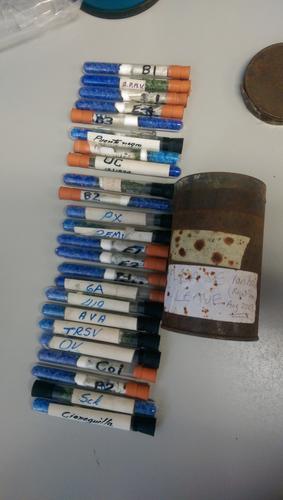当前位置:
X-MOL 学术
›
Plant Pathol.
›
论文详情
Our official English website, www.x-mol.net, welcomes your
feedback! (Note: you will need to create a separate account there.)
Historical virus isolate collections: An invaluable resource connecting plant virology’s pre‐sequencing and post‐sequencing eras
Plant Pathology ( IF 2.3 ) Pub Date : 2020-11-10 , DOI: 10.1111/ppa.13313 Roger A. C. Jones 1 , Neil Boonham 2 , Ian P. Adams 2, 3 , Adrian Fox 3
Plant Pathology ( IF 2.3 ) Pub Date : 2020-11-10 , DOI: 10.1111/ppa.13313 Roger A. C. Jones 1 , Neil Boonham 2 , Ian P. Adams 2, 3 , Adrian Fox 3
Affiliation

|
Many laboratories maintain historical collections of preserved plant virus isolates that store a wealth of untapped data, including original type isolates, studied in the pre‐sequencing era. Currently, many recently recognized virus species exist with no supporting reference sequences. Also, many virus sequences appear new when compared to available sequences, but, on sequencing pre‐sequencing era isolates, they may coincide. Such linkages allow access to data from previously determined biological and other parameters from pre‐sequencing era studies. These linkages are increasingly being found using high‐throughput sequencing, helping clarify virus taxonomy and improving understanding of virus ecology and evolution. Thus, mistakes can be avoided in naming viruses and in combining or separating them, as well as enabling identification of unknown viruses preserved long ago. With well‐established viruses, success in dating and other evolutionary studies, and discovery of changes in regional virus populations, both depend upon comparisons between recent and old isolate sequences covering the greatest possible time periods. Such studies help reveal the extent that human activities have influenced virus evolution and changed virus populations on a global scale. Sequencing virus genomes from herbarium specimens, archaeological specimens, or living plant collections can provide complementary data. By bringing context to newly detected viruses and supporting plant pest risk analyses, linking new virus discoveries to previously generated disease symptom, host range, virus transmission, and geographical distribution data has important implications for plant health regulation. Also, historical isolates can provide an invaluable resource facilitating biosecurity investigations involving virus introductions, entry pathways, and baseline surveillance.
中文翻译:

历史病毒分离物收藏:连接植物病毒学的前测序和后测序时代的宝贵资源
许多实验室维护着保存的植物病毒分离株的历史记录,这些分离物存储了许多尚未开发的数据,包括在测序前时代研究的原始类型的分离株。当前,存在许多没有支持的参考序列的最近识别的病毒种类。同样,与可用序列相比,许多病毒序列似乎是新的,但是在测序前期分离株时,它们可能是重合的。这样的联系允许从预先测序的时代研究中获得先前确定的生物学参数和其他参数的数据。这些联系越来越多地通过高通量测序发现,有助于阐明病毒分类并增进对病毒生态和进化的了解。因此,可以避免在命名病毒以及合并或分离病毒时出现错误,以及能够识别很久以前保存的未知病毒。对于成熟的病毒,成功进行约会和其他进化研究以及发现区域性病毒种群的变化,这都取决于对涵盖最大可能时间段的最新分离株和旧分离株进行比较。这些研究有助于揭示人类活动在全球范围内影响病毒进化和改变病毒种群的程度。从植物标本室标本,考古标本或有生命的植物中测序病毒基因组可以提供补充数据。通过为新发现的病毒提供背景信息并支持植物有害生物风险分析,将新的病毒发现与先前产生的疾病症状,宿主范围,病毒传播,地理分布数据对植物健康监管具有重要意义。同样,历史隔离株可以提供宝贵的资源,促进涉及病毒引入,进入途径和基线监测的生物安全调查。
更新日期:2021-01-06
中文翻译:

历史病毒分离物收藏:连接植物病毒学的前测序和后测序时代的宝贵资源
许多实验室维护着保存的植物病毒分离株的历史记录,这些分离物存储了许多尚未开发的数据,包括在测序前时代研究的原始类型的分离株。当前,存在许多没有支持的参考序列的最近识别的病毒种类。同样,与可用序列相比,许多病毒序列似乎是新的,但是在测序前期分离株时,它们可能是重合的。这样的联系允许从预先测序的时代研究中获得先前确定的生物学参数和其他参数的数据。这些联系越来越多地通过高通量测序发现,有助于阐明病毒分类并增进对病毒生态和进化的了解。因此,可以避免在命名病毒以及合并或分离病毒时出现错误,以及能够识别很久以前保存的未知病毒。对于成熟的病毒,成功进行约会和其他进化研究以及发现区域性病毒种群的变化,这都取决于对涵盖最大可能时间段的最新分离株和旧分离株进行比较。这些研究有助于揭示人类活动在全球范围内影响病毒进化和改变病毒种群的程度。从植物标本室标本,考古标本或有生命的植物中测序病毒基因组可以提供补充数据。通过为新发现的病毒提供背景信息并支持植物有害生物风险分析,将新的病毒发现与先前产生的疾病症状,宿主范围,病毒传播,地理分布数据对植物健康监管具有重要意义。同样,历史隔离株可以提供宝贵的资源,促进涉及病毒引入,进入途径和基线监测的生物安全调查。











































 京公网安备 11010802027423号
京公网安备 11010802027423号